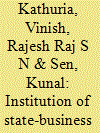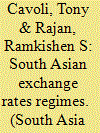|
|
|
Sort Order |
|
|
|
Items / Page
|
|
|
|
|
|
|
| Srl | Item |
| 1 |
ID:
121190


|
|
|
|
|
| Publication |
2013.
|
| Summary/Abstract |
This article empirically examines the determinants of trade development for South Asian countries over the period 1980-2010 using panel analysis. The result of unit root indicates that all the variables are appropriate for panel cointegration. The panel cointegration test reveals long-run relationship between trade ratio and its determinants. The panel fully modified ordinary least squares (FMOLS) long-run coefficients indicate that per capita income growth, trade liberalization, human capital, financial and infrastructure development have played a major role in influencing trade growth in South Asia.
|
|
|
|
|
|
|
|
|
|
|
|
|
|
|
|
| 2 |
ID:
121192


|
|
|
|
|
| Publication |
2013.
|
| Summary/Abstract |
The article investigates the impacts of imports and foreign capital inflows on economic growth of Pakistan over the period 1990 to 2010. We have applied the structural break autoregressive distributed lag (ARDL) bounds testing approach to cointegration to examine the long-run relationship between the variables. The vector error correction model (VECM) Granger causality multivariate framework is used to investigate the causal relationship between the series. Empirical analysis in this article confirms the long-run relationship between foreign capital inflows, imports and economic growth. The results indicate that foreign capital inflows and imports have positive and significant effect on economic growth in case of Pakistan. Causality analysis reveals the bidirectional causality between the variables, but strong causal relation is running from foreign capital inflows and imports to economic growth.
|
|
|
|
|
|
|
|
|
|
|
|
|
|
|
|
| 3 |
ID:
121196


|
|
|
|
|
| Publication |
2013.
|
| Summary/Abstract |
We explore the effect of female autonomy on individual fertility in Nepal. We find that families where wives have high level of autonomy have fewer children than other families. Using gender of the first child as a natural experiment, we also find that son preferences are present in Nepal. Moreover, the results indicate that women have more influence when the first born is a boy, compared to when the first child is a girl. We discuss policy implications with respect to the problem of excess children due to son preference.
|
|
|
|
|
|
|
|
|
|
|
|
|
|
|
|
| 4 |
ID:
121194


|
|
|
|
|
| Publication |
2013.
|
| Summary/Abstract |
Sri Lanka's geographic positioning has been long recognized as an opportunity that requires strategic exploitation in pursuance of the development objectives of the country. Improving connectivity between India and Sri Lanka is perceived as a main avenue for exploiting this advantage. The re-establishment of the Indo-Lanka ferry operations, which discontinued 25 years ago owing to security concerns, is a step in this direction. This article presents the findings of a research to examine the viability of this ferry operation venture from a Sri Lankan viewpoint. It appraises comparative economics involved in long-distance ferry transportation of passengers between India and Sri Lanka. Possible demand scenarios are appraised based on the preference to shift modes expressed by aviation passengers. Viability is assessed according to selected service supply capacity options, fare levels and associated risks. Policies and strategies to improve the operational viability of the venture for a Sri Lankan investor are also discussed.
|
|
|
|
|
|
|
|
|
|
|
|
|
|
|
|
| 5 |
ID:
121193


|
|
|
|
|
| Publication |
2013.
|
| Summary/Abstract |
Empirical studies on total factor productivity growth (TFPG) in developing countries highlight trade openness, research and development and market structure as being the most important determinants of TFPG. The role of institutions remains overlooked in the literature on the determinants of TFPG. In this article, we look into the role of institutional quality as captured by effective state-business relationships (SBRs) in influencing TFPG, using Indian manufacturing as a case study. By SBRs we mean a set of highly institutionalized, responsive and public interactions between the state and the business sector. To compute TFPG, we use firm level data for both the formal and informal manufacturing sectors. We correct for the simultaneity bias associated with the production function approach for TFPG estimation by employing a method developed by Levinsohn and Petrin. We propose measures of effective SBRs for 15 Indian states over the period 1994-2005, and then use them in TFPG equations to estimate the effect of SBR on TFPG. The results indicate that SBR has positively affected the TFPG of Indian industry. The effect, however, is primarily for the formal sector.
|
|
|
|
|
|
|
|
|
|
|
|
|
|
|
|
| 6 |
ID:
121191


|
|
|
|
|
| Publication |
2013.
|
| Summary/Abstract |
The formation of the South Asian Association of Regional Cooperation (SAARC) in the mid-1980s was aimed at achieving regional integration and economic growth. Hence, examining output interrelationships among South Asian economies becomes imperative, but work on this aspect has remained conspicuously absent. This study finds a long-run equilibrium relationship over the 1973-2010 period among five major South Asian nations: Bangladesh, India, Nepal, Pakistan and Sri Lanka. Bangladesh and India registered faster growth than other nations in South Asia since the liberalization in the early 1990s. Not only do these two countries appear to have achieved higher output cointegration than any of the other subgroups, but they also exert maximum influence on their neighbours. Liberalization and output cointegration along with high growth appear to be positively associated in South Asian nations. These findings have policy implications for other developing countries that aspire to grow fast, but lack adequate measures on regional integration.
|
|
|
|
|
|
|
|
|
|
|
|
|
|
|
|
| 7 |
ID:
121189


|
|
|
|
|
| Publication |
2013.
|
| Summary/Abstract |
This article presents an analysis of the degree of de facto exchange rate flexibility in the exchange rate regimes for selected South Asian economies, viz., Bangladesh, India, Pakistan and Sri Lanka. Three commonly employed measures of exchange rate classification are used: a simple exchange market pressure (EMP) measure, a GARCH specification and a regression-based model. The article finds strong evidence of limited flexibility in all the South Asian economies-particularly against the US dollar, which can suggest a heavy degree of currency management. While Bangladesh, Pakistan and Sri Lanka effectively have fixed exchange rate regimes vis-à-vis the US dollar, India appears to operate somewhat more as a managed floater with a movement towards greater flexibility in recent years.
|
|
|
|
|
|
|
|
|
|
|
|
|
|
|
|
| 8 |
ID:
121195


|
|
|
|
|
| Publication |
2013.
|
| Summary/Abstract |
In recent years there has been a great deal of interest in soaring food prices in India, as evidenced by wide discussions on causes of food inflation and its influence on near double-digit overall inflation in 2010 and 2011. This article examines the mix of drivers behind food price inflation through surveying recent evidence. Using this approach, this article demonstrates that the increase in demand for protein and vitamin-based high value food items has been the main driver of recent food inflation although supply shocks and institutional factors are important determinants of food inflation. These findings draw on the idea, as indicated by policy analysts, that finding proper policy response to rising food prices, mainly driven by increasing demand, will be a major challenge in India.
|
|
|
|
|
|
|
|
|
|
|
|
|
|
|
|
|
|
|
|
|